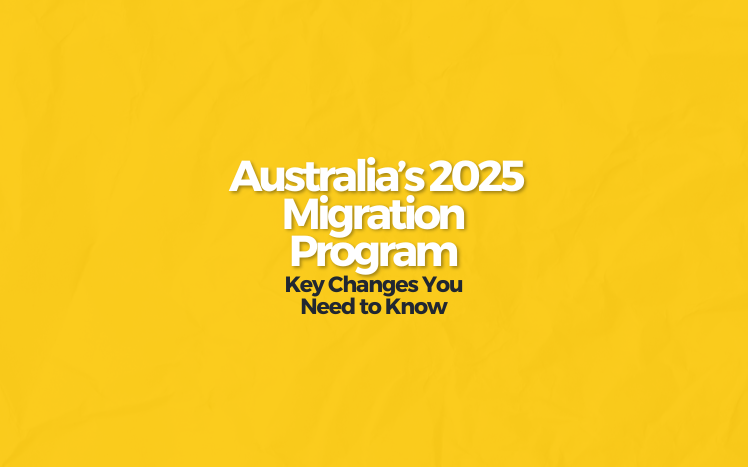Australia’s immigration system continues to evolve in 2025, with a range of changes to visa rules, planning levels, skilled migration pathways and policy settings. For anyone considering migrating, studying or working in Australia, understanding these changes is essential. Here’s your in-depth, fact-based guide to the 2025–26 Migration Program and what you should know.
1. What is the Migration Program Planning Level?
The “Migration Program” refers to the annual cap set by the Department of Home Affairs (DHA) on the number of permanent visas granted under various streams (skilled, family, special eligibility, etc.). These planning levels provide certainty for applicants, employers, states and territories.
Table 1: 2025–26 Planning Levels at a Glance

Key point: For 2025–26 the total cap remains at 185,000 places—unchanged from 2024-25.
2. What’s New in 2025 – Major Changes & Trends
A. Stability + Predictability
The decision to maintain the migration cap at 185,000 places signals a shift toward a multi-year planning horizon, giving employers and migrants more certainty.
B. Emphasis on Skilled Migration
With 71% of places allocated to the Skilled Stream, Australia continues to prioritise skilled migrants who can support the economy, fill labour shortages and contribute to innovation.
C. New “Talent & Innovation” Focus
A new category has been introduced to consolidate previous programs: the National Innovation Visa / Talent & Innovation stream (about 4,300 places) will replace the former Global Talent and Distinguished Talent visa models.
D. Higher Salary / Income Thresholds for Skilled Visas
From 1 July 2025, certain skilled visa subclasses will face increased income/salary thresholds (e.g., Core Skills Income Threshold, Specialist Skills).
E. More Regional & State-Nomination Focus
Australia continues to push for regional migration and greater state/territory involvement—applicants willing to live and work in regional areas may have stronger chances.
F. Streamlining & Visa Subclass Reforms
The migration system is undergoing simplification: fewer visa subclasses, clearer categories, and reform of older streams such as the TSS (Temporary Skill Shortage) visa replaced by newer models.
3. What These Changes Mean for Applicants & Migrants
Skilled Applicants
– If you apply under a skilled stream, your chances remain strong—but competition may increase due to stable cap and higher thresholds.
– You’ll need to meet higher salary benchmarks, have in-demand occupations and possibly accept regional posts for added advantage.
– The “Talent & Innovation” stream offers a route for high-achievers in tech, research or innovation sectors.
Family Migration
– The Family stream remains sizable (~52,500 places) but is still behind Skilled in share. Expect processes and competition to remain.
– Applicants for partner, child and parent visas should focus on completeness of documentation and timeliness.
Student & Temporary Visa Holders
– Although the permanent program doesn’t directly cover temporary visas, changes in skilled streams can affect your pathway to PR (e.g., work after study, regional qualification).
– You may need to adapt your study/work choices (e.g., choosing regional institutions, selecting jobs aligned with priority occupations) to align with migration policy.
Employers & Sponsors
– Employers sponsoring migrant workers must ensure they meet increased thresholds, skill requirements and compliance obligations.
– Hiring migrants in priority/innovation sectors becomes strategic.
4. Timeline of Key Implementation Dates

5. Practical Tips for Migrants Considering 2025–26
- Lodge early: Apply as soon as you’re eligible—seats are fixed at planning levels.
- Choose in-demand occupations: Align with Australia’s skill shortage needs, regionally dependent.
- Check updated salary thresholds: Especially for employer-sponsored or specialist streams.
- Consider regional migration: regional study or work can boost your profile.
- Use registered migration advice: complex rules and thresholds mean professional help adds value.
6. Why the Government Made These Changes
The 2025 migration programme reflects several strategic goals:
- Sustaining workforce and economic growth: Skilled migration helps fill gaps in infrastructure, health, tech and regional industries.
- Ensuring migration is sustainable: Stable cap helps manage housing, infrastructure, transport and community capacities.
- Focusing on innovation: Emphasis on the Talent & Innovation stream underscores the importance of global talent in R&D and future industries.
- Regional development: Encouraging migration to regional Australia helps spread growth and reduce pressure on capital cities.
7. Summary & Key Takeaways
Australia’s 2025-26 Migration Program offers continuity and clarity with a total cap of 185,000 permanent places. The major shifts are not in volume but in emphasis—toward skilled, regional, and innovation-driven migration, with higher salary thresholds and a simplified visa design. For prospective migrants, students, employers and states, the message is: align your choices with Australia’s strategic priorities and plan ahead.
If you’d like, I can create a downloadable infographic summarising the 2025 migration programme changes or a table of key visa subclasses with updated thresholds for you.


